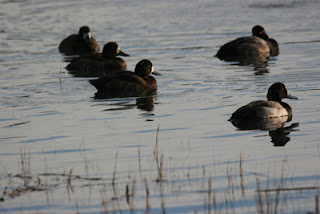Photography ©SFBAYIMAGES.com (Buy or License Photo)
Bottoms Up!.
San Francisco Bay Area Birdwatching
SeaBirds of Marin, SF Bay and Gulf of the Farallones
SeaBirds of Marin, SF Bay and Gulf of the Farallones
Greater Scaup
Scientific classification
- Kingdom: Animalia
- Phylum: Chordata
- Class: Aves
- Order: Anseriformes
- Family: Anatidae
- Genus: Aythya
- Species: A. marila
- Aythya marila
Description:
The Greater Scaup (Aythya marila), just Scaup in Europe, or colloquially known as "Bluebill", is a small diving duck. It breeds on the ground by lakes and bogs on the tundra and at the northern limits of the boreal forest across Arctic and subarctic regions of northern North America, Europe and Asia.
The adult Greater Scaup is 42-51 cm long with a 71-80 cm wingspan, larger than the Lesser Scaup. It has a blue bill and yellow eyes. The male has a dark head with a green sheen, a black breast, a light back, a black tail and a white bottom. The adult female has a white band at the base of the bill and a brown head and body.
Nearctic Greater Scaup are separable from Palaearctic birds by stronger vermiculation on the mantle and scapulars, and are considered a separate subspecies, A. m. nearctica. Based on size differences, a Pleistocene paleosubspecies Aythya marila asphaltica has also been described from fossils recovered at Binagady, Azerbaijan.
Greater Scaup migrate southwards to winter in flocks to coastal waters.
The Greater Scaup mainly eats mollusks and aquatic plants, obtained by diving and swimming underwater. There is a report[1] of four Greater Scaups swallowing leopard frogs (with body length about 5 cm (2 inches)) which they dredged out of a roadside freshwater pond.
The Greater Scaup's name may come from its display call scaup scaup. It is usually silent when not breeding.
The Greater Scaup (Aythya marila), just Scaup in Europe, or colloquially known as "Bluebill", is a small diving duck. It breeds on the ground by lakes and bogs on the tundra and at the northern limits of the boreal forest across Arctic and subarctic regions of northern North America, Europe and Asia.
The adult Greater Scaup is 42-51 cm long with a 71-80 cm wingspan, larger than the Lesser Scaup. It has a blue bill and yellow eyes. The male has a dark head with a green sheen, a black breast, a light back, a black tail and a white bottom. The adult female has a white band at the base of the bill and a brown head and body.
Nearctic Greater Scaup are separable from Palaearctic birds by stronger vermiculation on the mantle and scapulars, and are considered a separate subspecies, A. m. nearctica. Based on size differences, a Pleistocene paleosubspecies Aythya marila asphaltica has also been described from fossils recovered at Binagady, Azerbaijan.
Greater Scaup migrate southwards to winter in flocks to coastal waters.
The Greater Scaup mainly eats mollusks and aquatic plants, obtained by diving and swimming underwater. There is a report[1] of four Greater Scaups swallowing leopard frogs (with body length about 5 cm (2 inches)) which they dredged out of a roadside freshwater pond.
The Greater Scaup's name may come from its display call scaup scaup. It is usually silent when not breeding.
Other Information: In North America, Greater Scaup populations have been on a steady decline since the 1990's. Biologists and conservationists are unsure the reasons for decline. Some researchers believe a parasitic trematode found in snails may be to blame. The Scaup was one of the birds profoundly affected by the Nov. 2008 oil spill on the San Francisco Bay. Being a sea bird, it likes to stay in the water and the water was a bad place to be that week.
They look to me like they are always smiling and have a joke in their mind. Their eyes seem very alert and playful. This is obviously not a scientific observation. I learn alot about animals by studying their behavior in the photographs I take and how they respond to being photographed. In all honesty, I really had a hard time discerning if these were Lesser Scaups or Great Scaups, but the males do have a green sheen to their head rather then the purple sheen Lesser Scaups are supposed to have.
They look to me like they are always smiling and have a joke in their mind. Their eyes seem very alert and playful. This is obviously not a scientific observation. I learn alot about animals by studying their behavior in the photographs I take and how they respond to being photographed. In all honesty, I really had a hard time discerning if these were Lesser Scaups or Great Scaups, but the males do have a green sheen to their head rather then the purple sheen Lesser Scaups are supposed to have.







No comments:
Post a Comment